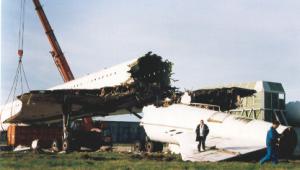22nd Aug 2010, 21:04
permalink Post: 73
Quote:
|
I have yet another couple of questions and I hope all you Concorde experts don't mind me taking up your valuable time.
|
And I enjoy answering those questions, if and whenever I can!
Quote:
| As regards fuel burn: was there any difference between each indvidual airframe and if so was it significant enough to be considered when calculating the trip fuel? |
It was one reason why, when Air France withdrew an aircraft from service, Fox Delta was the first one to go.
Also, due to the gradual improvements in production methods, and minor redesign, the last British production Concorde, G-BOAF, was about a ton lighter than the first one (G-BOAC). While the differences weren't huge, they were noticeable.
Quote:
| Also did different engines also have slightly different fuel consumption? |
Quote:
| Whilst on the subject of engines, I just wondered how many were required to keep the BA Concorde fleet flying? What sort of useful life could be expected from the engines? |
According to 'Wikipedia', 67 engines were built, which would mean, in theory , 64 engines for 16 aircraft and 3 spares....
In practice, of course, fewer aircraft flew at any one time, so the statistics are different, but even so, a lot of engine swapping went on over the years.
As to the MTBO, I don't know... it's not my field at all....
22nd Aug 2010, 22:54
permalink Post: 76
The story has never been fully elucidated....
But in brief, F-BVFD made an extremely hard landing at Dakar in November 1977, with a vertical speed in the order of 14 ft/sec (with 10 ft/sec being the formal limit).
The result was a major tailstrike, ruining the tail wheel and some of the tail structure.
The aircraft was repaired, repatriated, and put back into service, but it was the first one to be withdrawn from service when the Paris-Dakar-Rio route was closed.
In the end it was scrapped in 1994... only a section of the forward fuselage still remains in the stores of the Air and Space Museum at Le Bourget (Paris).
But in brief, F-BVFD made an extremely hard landing at Dakar in November 1977, with a vertical speed in the order of 14 ft/sec (with 10 ft/sec being the formal limit).
The result was a major tailstrike, ruining the tail wheel and some of the tail structure.
The aircraft was repaired, repatriated, and put back into service, but it was the first one to be withdrawn from service when the Paris-Dakar-Rio route was closed.
In the end it was scrapped in 1994... only a section of the forward fuselage still remains in the stores of the Air and Space Museum at Le Bourget (Paris).
10th Jul 2012, 09:10
permalink Post: 1655
@CliveL
Quote:
| Partly out of equal shares, but there was also more flight test development work than could be handled by just one aircraft in a reasonable timescale, and each partner had their own sphere of responsibility to cover so if you have to have two airframes it made some sense to have one each. |
A few pages earlier on this thread some of you have posted some of their favourite photos of Concorde. Here are very sad, chocking and rare photos:


This is 211 (F-BVFD) after "Air France's special treatment" (shame on them). The photos were taken in 1994. More photos of this can be seen here: Maripa : Documentation photographique.
To compensate, here's one of my favourite:

Most of those photos were taken at Toulouse (we saw a lot from Filton in this thread but very few from France). The caption of the top left picture says it is 102 (F-WTSA) and 201 (F-WTSB) in the background. The image comes from a french website ( Concorde dans la presse de 1965 \xe0 2003 ) gathering hundreds of articles about Concorde. Very interesting but in French only.
I particulary like this last serie of photos because it shows the process of a dream turning into reality, the beginning of such a beautiful adventure and the symbol of a time where national pride and technical achievment had more importance and value than the basic investment/profitability ratio that rules the world today! And now, more than 40 years later, not only we are not able to build a SST but we are also not able to make a SST flying again.
And this leads to a new question (maybe another 64000$ one):
As we can see in those photos and as I have seen in photos from Filton, several pre-production and production airframes were built at the same time. Did the fabrication of pre-production or production a/c had to be stopped at some point to wait for in flight test results? Similar question: did the early flights revealed unforseen problems that needed to be sorted out before the program can move on?
